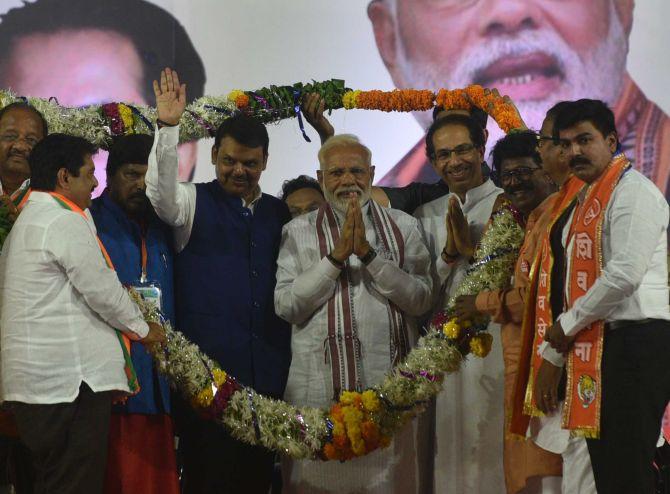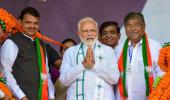The BJP in the last few years lost a major ally like Telugu Desam Party but also gained a big regional partner like All India Anna Dravida Munnetra Kazhagam and several smaller allies in northeastern states.

The Bharatiya Janata Party on Monday lost its oldest and the only major Hindutva ally as the Shiv Sena, its partner for more than three decades, walked out of the Modi government at the Centre.
The decision of the Maharashtra party to snap ties came following years of unease in the alliance and reached a flash point after the recent assembly election results, with the Sena accusing the BJP of breaking "promise" of equal division of power in the state.
The BJP has asserted that it had never agreed to share the post of chief minister, as claimed by Sena president Uddhav Thackeray.
The divorce between the two parties wedded to the Hindutva ideology finally happened after an acrimonious relationship over the last five years.
The first strains in their ties surfaced in the 2014 assembly polls when they fought separately after the Sena's refusal to part with the number of seats the BJP wanted.
As Prime Minister Narendra Modi led the BJP to an unprecedented win in the 2014 Lok Sabha polls, it sensed an opening in Maharashtra to oust Sena from the position of senior ally, a position the party founded by Bal Thackeray had enjoyed till his reign.
The Sena was forced to become the junior partner as the BJP won 122 seats in the 288-member assembly while it won 63.
They joined hands to form the government, with the BJP's Devendra Fadnavis becoming the chief minister.
The first and only saffron government in the state earlier between 1995-2000 was headed by Sena leaders.
The Sena, however, never reconciled to its reduced status as the lotus bloomed in one local poll after another and the BJP under Modi and its president Amit Shah also became the flag bearer of Hindutva with Thackeray's party following in its shadow.
Through its mouthpiece Saamana and sundry leaders Sena kept attacking the Modi government off and on and even blocked its leader Anil Desai from joining as a minister in the Centre.
That it was never given portfolios of its choice at either the Centre or the state always remained an irritant for the party.
With 18 members in Lok Sabha, the Sena was the biggest National Democratic Alliance constituent after the BJP but its departure will not make any difference to the government's stability as the ruling party alone has 303 MPs in the 543-member House.
While on the one hand Sena's severing ties with the NDA underscores the BJP's growing hegemony which forced an avowed secular party like the Congress to mull supporting a strident Hindutva party like the Sena, it also highlights how the ruling party's expansionist drive under Modi and Amit Shah has made its allies of decades uneasy.
Bihar chief minister Nitish Kumar, who heads the Janata Dal-United, hardly shares the same level of warmth with the BJP since his return to the NDA in 2016 that he did when he was part of the saffron alliance for more than 15 years before breaking ties in 2013.
Kumar's party has refused to join the Modi government as it believes that it was not offered its due share.
Akali Dal -- the second oldest BJP ally after the Sena -- has often in the past expressed its reservations over its ally's policies.
The BJP in the last few years lost a major ally like Telugu Desam Party but also gained a big regional partner like All India Anna Dravida Munnetra Kazhagam and several smaller allies in northeastern states.










